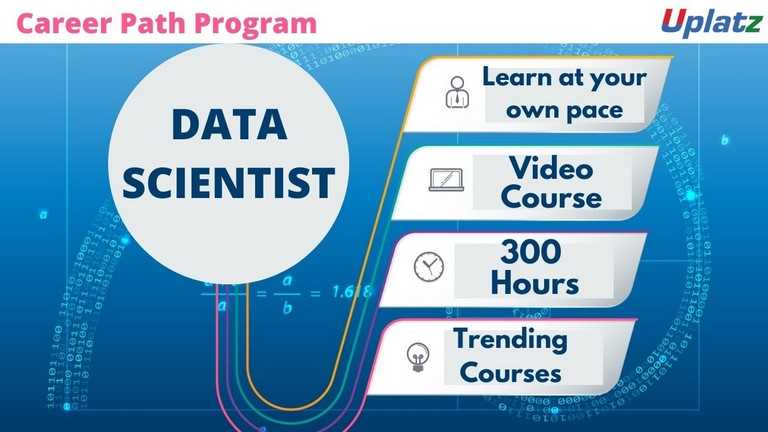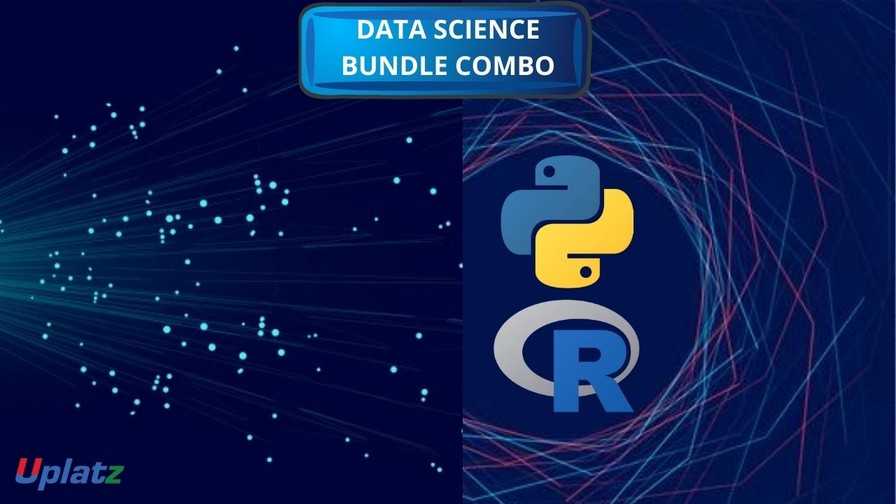Interview Questions - Data Science
You'll review the common questions asked in data science, data analyst, and machine learning interviews.Preview Interview Questions - Data Science course
Price Match Guarantee Full Lifetime Access Access on any Device Technical Support Secure Checkout Course Completion Certificate 95% Started a new career
BUY THIS COURSE (
95% Started a new career
BUY THIS COURSE (GBP 12 GBP 29 )-
 100% Got a pay increase and promotion
100% Got a pay increase and promotion
Students also bought -
-

- Career Path - Data Scientist
- 300 Hours
- GBP 32
- 6978 Learners
-

- Build your Career in Data Science
- 3 Hours
- GBP 12
- 600 Learners
-

- Bundle Combo - Data Science (with Python and R)
- 70 Hours
- GBP 22
- 3110 Learners

Data Science job interviews can be daunting. Technical interviewers often ask you to design an experiment or model. You may need to solve problems using Python and SQL. You will likely need to show how you connect data skills to business decisions and strategy.
Data science is one of the most in-demand careers today. According to The Economic Times, the number of job advertisements for Data Science profiles has increased by 400% in the last year. So, if you want to start a career as a Data Scientist, here are some top Data Science interview questions and answers to assist you succeed. Data Science is one of the most well-known and widely used technologies in the world today. Professionals in this industry are being hired by major corporations. Data Scientists are among the highest-paid IT professionals due to their high demand and limited supply.
It should come as no surprise that data scientists are becoming rock stars in the new era of big data and machine learning. Companies who can use vast volumes of data to enhance the way they service consumers, produce products, and operate their operations will fare well in this economy. And, if you're pursuing a career as a data scientist, you'll need to be ready to wow potential employers with your expertise. And in order to do so, you'll need to be able to ace your next data science interview in one sitting! We've compiled a list of the most often asked data science interview questions so you can prepare for your next interview!
If you genuinely understand how the code works, you will be able to succeed in any real-life interview questions. The purpose of this course is for you to master the crucial skills, methods, and concepts that will enable you to succeed in any real-world interview situation. When you finish this course, you'll have a good understanding of data structures, algorithms, and interview questions, but more importantly, you'll have mastered the ideas, techniques, and methods that will help you succeed in every other interview question. You'll be much more confident going into any Data Science interviews you have coming up.
In this Data Science Interview Questions course by Uplatz, you'll review the common questions asked in data science, data analyst, and machine learning interviews. You'll learn how to answer machine learning questions about predictions, underfitting and overfitting. You'll walk through typical data analyst questions about statistics and probability. Then, you'll dive deeper into the data structures and algorithms you need to know. You'll also learn tips for answering questions like, "Tell me about one of your recent projects." At the end of the course, you'll have a chance to practice what you've learned. Practice the skills you need to show up for your data science interview with confidence!
Course/Topic - Interview Questions - Data Science - all lectures
-
In this lecture, we will go through different basic questions about Data Science. What is data science, regression in data science, tree learning, supervised unsupervised data, etc?
-
Here we will get the answers to questions like what is the difference between univariate, bivariate, multivariate analysis, different selection methods, and some logical questions about data science, etc.
-
In this lecture, we will discuss important questions asked in interviews like what is k-means, how to calculate accuracy using a confusion matrix, what is a recommender system, etc?
-
Here we will look at questions like what is linear regression, Naive- Bayes theorem, Ensemble learning, Eigenvalue, and Eigenvector, etc.
-
Here we will understand what is difference between data science and data analytics, why data cleansing is important, reinforcement learning, precision, etc.
After successful completion of this course you will be able to:
• Be well-prepared for any Data Science interviews you may have.
• Learn and understand how algorithms work and how to write them out
• Perform wonderfully on a wide range of Data Science interview questions
• How to write important data structures out.
• Make your own algorithms that can perform any task you choose.
• This course will guide you to brush up on the skills of data science to crack the interview.
• Here, our focus will be on real-world scenario Data Science interview questions asked about linear and logistic regression etc., And how to answer them.
• This course can help you learn the key concepts required to build your data science career.
The Data Science Certification ensures you know planning, production and measurement techniques needed to stand out from the competition.
Data scientists examine which questions need answering and where to find the related data. They have business acumen and analytical skills as well as the ability to mine, clean, and present data. Businesses use data scientists to source, manage, and analyze large amounts of unstructured data.
Already, demand is high, salaries are competitive, and the perks are numerous – which is why Data Scientist has been called “the most promising career” by LinkedIn and the “best job in America” by Glassdoor.
You'll typically need a mathematical, engineering, computer science or scientific-related degree to get a place on a course, although subjects such as business, economics, psychology or health may also be relevant if you have mathematical aptitude and basic programming experience.
Uplatz online training guarantees the participants to successfully go through the Data Science Certification provided by Uplatz. Uplatz provides appropriate teaching and expertise training to equip the participants for implementing the learnt concepts in an organization.
Course Completion Certificate will be awarded by Uplatz upon successful completion of the Data Science online course.
The Data Science draws an average salary of $137,000 per year depending on their knowledge and hands-on experience.
Data scientists are one of the highest-paid employees of most companies. According to Analytics India Magazine research, around 1,400 data science professionals working in India make more than Rs 1 crore salary.
You can think about the data increase from IoT or from social data at the edge. If we look a little bit more ahead, the US Bureau of Labor Statistics predicts that by 2026—so around six years from now—there will be 11.5 million jobs in data science and analytics.
Any fresher can become a Data Scientist the only need is to learn the tricks of the business and required skills.
● Data Engineer. Data engineers are experts at accessing, and moreover, processing vast amounts of real-time data. ...
● Data Analyst. ...
● Data Scientist. ...
● Machine Learning Engineer. ...
● Statisticians and Mathematicians. ...
● Business Analyst. ...
● Marketing Analyst. ...
● Clinical Data Managers.
1. What does one understand by the term Data Science?
An interdisciplinary field that constitutes various scientific processes, algorithms, tools, and machine learning techniques working to help find common patterns and gather sensible insights from the given raw input data using statistical and mathematical analysis is called Data Science.
The following figure represents the life cycle of data science.
· It starts with gathering the business requirements and relevant data.
· Once the data is acquired, it is maintained by performing data cleaning, data warehousing, data staging, and data architecture.
· Data processing does the task of exploring the data, mining it, analyzing it which can be finally used to generate the summary of the insights extracted from the data.
· Once the exploratory steps are completed, the cleansed data is subjected to various algorithms like predictive analysis, regression, text mining, recognition patterns, etc depending on the requirements.
· In the final stage, the results are communicated to the business in a visually appealing manner. This is where the skill of data visualization, reporting, and different business intelligence tools come into the picture.
2. What is the difference between data analytics and data science?
· Data science involves the task of transforming data by using various technical analysis methods to extract meaningful insights using which a data analyst can apply to their business scenarios.
· Data analytics deals with checking the existing hypothesis and information and answers questions for a better and effective business-related decision-making process.
· Data Science drives innovation by answering questions that build connections and answers for futuristic problems. Data analytics focuses on getting present meaning from existing historical context whereas data science focuses on predictive modeling.
· Data Science can be considered as a broad subject that makes use of various mathematical and scientific tools and algorithms for solving complex problems whereas data analytics can be considered as a specific field dealing with specific concentrated problems using fewer tools of statistics and visualization.
3. What are some of the techniques used for sampling? What is the main advantage of sampling?
Data analysis can not be done on a whole volume of data at a time especially when it involves larger datasets. It becomes crucial to take some data samples that can be used for representing the whole population and then perform analysis on it. While doing this, it is very much necessary to carefully take sample data out of the huge data that truly represents the entire dataset.
There are majorly two categories of sampling techniques based on the usage of statistics, they are:
· Probability Sampling techniques: Clustered sampling, Simple random sampling, Stratified sampling.
· Non-Probability Sampling techniques: Quota sampling, Convenience sampling, snowball sampling, etc.
4. List down the conditions for Overfitting and Underfitting.
Overfitting: The model performs well only for the sample training data. If any new data is given as input to the model, it fails to provide any result. These conditions occur due to low bias and high variance in the model. Decision trees are more prone to overfitting.
Underfitting: Here, the model is so simple that it is not able to identify the correct relationship in the data, and hence it does not perform well even on the test data. This can happen due to high bias and low variance. Linear regression is more prone to Underfitting.
5. Differentiate between the long and wide format data.
|
Long format Data |
Wide-Format Data |
|
Here, each row of the data represents the one-time information of a subject. Each subject would have its data in different/ multiple rows. |
Here, the repeated responses of a subject are part of separate columns. |
|
The data can be recognized by considering rows as groups. |
The data can be recognized by considering columns as groups. |
|
This data format is most commonly used in R analyses and to write into log files after each trial. |
This data format is rarely used in R analyses and most commonly used in stats packages for repeated measures ANOVAs. |
6. What are Eigenvectors and Eigenvalues?
Eigenvectors are column vectors or unit vectors whose length/magnitude is equal to 1. They are also called right vectors. Eigenvalues are coefficients that are applied on eigenvectors which give these vectors different values for length or magnitude.
A matrix can be decomposed into Eigenvectors and Eigenvalues and this process is called Eigen decomposition. These are then eventually used in machine learning methods like PCA (Principal Component Analysis) for gathering valuable insights from the given matrix.
7. What does it mean when the p-values are high and low?
A p-value is the measure of the probability of having results equal to or more than the results achieved under a specific hypothesis assuming that the null hypothesis is correct. This represents the probability that the observed difference occurred randomly by chance.
· Low p-value which means values ≤ 0.05 means that the null hypothesis can be rejected and the data is unlikely with true null.
· High p-value, i.e values ≥ 0.05 indicates the strength in favor of the null hypothesis. It means that the data is like with true null.
· p-value = 0.05 means that the hypothesis can go either way.
8. When is resampling done?
Resampling is a methodology used to sample data for improving accuracy and quantify the uncertainty of population parameters. It is done to ensure the model is good enough by training the model on different patterns of a dataset to ensure variations are handled. It is also done in the cases where models need to be validated using random subsets or when substituting labels on data points while performing tests.
9. What do you understand by Imbalanced Data?
Data is said to be highly imbalanced if it is distributed unequally across different categories. These datasets result in an error in model performance and result in inaccuracy.
10. Are there any differences between the expected value and mean value?
There are not many differences between these two, but it is to be noted that these are used in different contexts. The mean value generally refers to the probability distribution whereas the expected value is referred to in the contexts involving random variables.
11. What do you understand by Survivorship Bias?
This bias refers to the logical error while focusing on aspects that survived some process and overlooking those that did not work due to lack of prominence. This bias can lead to deriving wrong conclusions.
12. Define the terms KPI, lift, model fitting, robustness and DOE.
· KPI: KPI stands for Key Performance Indicator that measures how well the business achieves its objectives.
· Lift: This is a performance measure of the target model measured against a random choice model. Lift indicates how good the model is at prediction versus if there was no model.
· Model fitting: This indicates how well the model under consideration fits given observations.
· Robustness: This represents the system’s capability to handle differences and variances effectively.
· DOE: stands for the design of experiments, which represents the task design aiming to describe and explain information variation under hypothesized conditions to reflect variables.
13. Define confounding variables.
Confounding variables are also known as confounders. These variables are a type of extraneous variables that influence both independent and dependent variables causing spurious association and mathematical relationships between those variables that are associated but are not casually related to each other.
14. How are the time series problems different from other regression problems?
· Time series data can be thought of as an extension to linear regression which uses terms like autocorrelation, movement of averages for summarizing historical data of y-axis variables for predicting a better future.
· Forecasting and prediction is the main goal of time series problems where accurate predictions can be made but sometimes the underlying reasons might not be known.
· Having Time in the problem does not necessarily mean it becomes a time series problem. There should be a relationship between target and time for a problem to become a time series problem.
· The observations close to one another in time are expected to be similar to the ones far away which provide accountability for seasonality. For instance, today’s weather would be similar to tomorrow’s weather but not similar to weather from 4 months from today. Hence, weather prediction based on past data becomes a time series problem.
15. Suppose there is a dataset having variables with missing values of more than 30%, how will you deal with such a dataset?
Depending on the size of the dataset, we follow the below ways:
· In case the datasets are small, the missing values are substituted with the mean or average of the remaining data. In pandas, this can be done by using mean = df.mean() where df represents the pandas dataframe representing the dataset and mean() calculates the mean of the data. To substitute the missing values with the calculated mean, we can use df.fillna(mean).
· For larger datasets, the rows with missing values can be removed and the remaining data can be used for data prediction.









